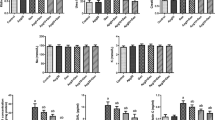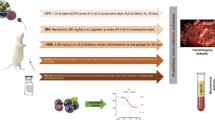Abstract
Objective
Drug-induced nephrotoxicity is a major cause of kidney injury. Aminoglycosides, like amikacin, are effective gram-negative antibiotics. However, its distinct induction of nephrotoxicity is a problematic clinical issue. This study investigated the preventive benefits of citrus bergamot extract in rats with acute renal injury caused by amikacin.
Methods
Five groups of six rats each received treatments for nine days: Group 1, normal control group, was gavaged DW orally. Group 2, negative control group, was gavaged DW orally plus a toxic dose of amikacin (1.2 g/kg) intraperitoneally on day 7 of the research protocol. Group 3, comparison group, was given 100 mg/kg of citrus bergamot extract. Groups (4) and (5), tested groups, gavaged citrus bergamot extract (100 and 200 mg/kg, respectively) orally and a toxic dose of amikacin (1.2 g/kg) intraperitoneally on day 7. Groups (1) and (3) administered intraperitoneal saline on day 7 to mimic the other groups. Serum, urine, tissue indicators of oxidative stress and renal histopathology were used to characterize nephrotoxicity.
Results
The results showed that amikacin produced nephrotoxicity by increasing the weight of the rats' kidneys and a substantial increase in the urine beta2-microglobuline as well as serum traditional biomarkers for kidney injury, urea and creatinine. Additionally, amikacin markedly raises serum cytokine levels (IL-6). Amikacin, on the other hand, significantly lowered renal antioxidant activity as measured by changes in serum malondialdehyde levels and reduced glutathione activity in this experiment. This was reinforced by the existence of significant morphological changes in the kidney. Citrus bergamot extract was able to restore renal function, accompanied by significant improvements in the aforementioned parameters of kidney function, inflammation, and oxidative stress indicators, as well as an attenuation of histopathological change.
Conclusion
According to biochemical and histological studies, citrus bergamot extract counteracts the detrimental effects of amikacin on renal structure and function.






Similar content being viewed by others
References
Vaidya VS, Ferguson MA, Bonventre JV (2008) Biomarkers of acute kidney injury. Annu Rev Pharmacol Toxicol 48:463–493
Harrill AH, Lin H, Tobacyk J, Seely JC (2018) Mouse population-based evaluation of urinary protein and miRNA biomarker performance associated with cisplatin renal injury. Exp Biol Med 243(3):237–247
Barnett LMA, Cummings BS (2019) Cellular and molecular mechanisms of kidney toxicity. Semin Nephrol 39(2):141–151
Ronco C, Bellomo R, Kellum JA (2019) Acute kidney injury. Lancet 394(10212):1949–1964
Kadurugamuwa JL, Clarke AJ, Beveridge TJ (1993) Surface action of gentamicin on Pseudomonas aeruginosa. J Bacteriol 175(18):5798–5805
Wargo KA, Edwards JD (2014) Aminoglycoside-induced nephrotoxicity. J Pharm Pract 27(6):573–577
Bayoumi KA, Fattah AA, Gaballah IF (2020) possible protective potential of atorvastatin and black seed (nigella sativa) oil in amikacin-induced nephrotoxicity in adult male albino rats. Egypt J Forensic Sci Appl Toxicol 20(3):55–65
Silva VLC, Gil FZ, Nascimento G, Cavanal MF (1987) Aminoglycoside and nephrotoxicity. Kidney Blood Press Res 10(6):327–337
Parlakpinar H, Koc M, Polat A, Vardi N, Ozer MK, Turkoz Y et al (2004) Protective effect of aminoguanidine against nephrotoxicity induced by amikacin in rats. Urol Res 32(4):278–282
Jadhav RW, Al KM, Jones LA, Vinu A, Bhosale SV (2019) The supramolecular self-assembly of aminoglycoside antibiotics and their applications. ChemistryOpen 8(9):1154–1166
Martínez-Salgado C, López-Hernández FJ, López-Novoa JM (2007) Glomerular nephrotoxicity of aminoglycosides. Toxicol Appl Pharmacol 223(1):86–98
Abdulidha NA, Jaccob AA, AL-Moziel MSG, (2020) Protective effects of Co-Q10, Ginkgo biloba, and l-carnitine on brain, kidney, liver, and endocrine system against sub-acute heavy metals toxicity in male rats. Toxicol Environ Health Sci 12(4):331–341
Pragasam SJ, Rasool M (2013) Dietary component p-coumaric acid suppresses monosodium urate crystal-induced inflammation in rats. Inflamm Res 62(5):489–498
Najeb SM, Jaccob AA, Al-Moziel MSG, Abdulhameed HM (2022) Cardioprotective and antioxidant effects of taxifolin and vitamin C against diazinone-induced myocardial injury in rats. Environ Health Toxicol 37(1):1–10
Sahu BD, Tatireddy S, Koneru M, Borkar RM, Kumar JM, Kuncha M et al (2014) Naringin ameliorates gentamicin-induced nephrotoxicity and associated mitochondrial dysfunction, apoptosis and inflammation in rats: possible mechanism of nephroprotection. Toxicol Appl Pharmacol 277(1):8–20
Bouzenna H, Dhibi S, Samout N, Rjeibi I, Talarmin H, Elfeki A et al (2016) The protective effect of Citrus limon essential oil on hepatotoxicity and nephrotoxicity induced by aspirin in rats. Biomed Pharmacother 83:1327–1334
Walker R, Janda E, Mollace V (2013) The use of bergamot-derived polyphenol fraction in cardiometabolic risk prevention and its possible mechanisms of action. Polyphen Hum Health Dis 2:1087–1105
Janda E, Lascala A, Martino C, Ragusa S, Nucera S, Walker R et al (2016) Molecular mechanisms of lipid- and glucose-lowering activities of bergamot flavonoids. PharmaNutrition 4:S8-18
Nogata Y, Sakamoto K, Shiratsuchi H, Ishii T, Yano M, Ohta H (2006) Flavonoid composition of fruit tissues of citrus species. Biosci Biotechnol Biochem 70(1):178–192
Risitano R, Currò M, Cirmi S, Ferlazzo N, Campiglia P, Caccamo D et al (2014) Flavonoid fraction of bergamot juice reduces LPS-induced inflammatory response through SIRT1-mediated NF-kB inhibition in THP-1 monocytes. PLoS ONE 9(9):e107431
Ferlazzo N, Visalli G, Smeriglio A, Cirmi S, Enrico Lombardo G, Campiglia P et al (2015) Flavonoid fraction of orange and bergamot juices protect human lung epithelial cells from hydrogen peroxide-induced oxidative stress. Evid Based Complement Alternat Med 2015:957031
Mannucci C, Navarra M, Calapai F, Squeri R, Gangemi S, Calapai G (2017) Clinical pharmacology of Citrus bergamia: a systematic review. Phyther Res 31(1):27–39
Vysakh A, Abhilash S, Kuriakose J, Midhun SJ, Jyothis M, Latha MS (2018) Protective effect of Rotula aquatica Lour against gentamicin induced oxidative stress and nephrotoxicity in Wistar rats. Biomed Pharmacother 106:1188–1194
Abdel-Daim MM, Ahmed A, Ijaz H, Abushouk AI, Ahmed H, Negida A et al (2019) Influence of Spirulina platensis and ascorbic acid on amikacin-induced nephrotoxicity in rabbits. Environ Sci Pollut Res 26(8):8080–8086
Noori HY, Abd AH (2019) Protective effect of melatonin, Rosuvastatin and their combination against amikacin induced nephrotoxicity in rats. Ann Trop Med Public Heal. 22(5):98–107
Fatima SN, Akhtar S, Shahid SM, Sajjad A, Bibi A (2021) Effect of salicylic acid supplementation on blood glucose, lipid profile and electrolyte homeostasis in gentamicin sulphate induced nephrotoxicity. Pak J Pharm Sci 34(3):1075–1079
Abdelrahman RS, Abdelmageed ME (2020) Renoprotective effect of celecoxib against gentamicin-induced nephrotoxicity through suppressing NFκB and caspase-3 signaling pathways in rats. Chem Biol Interact 5(315):108863
Miyata T, Jadoul M, Kurokawa K, Van C, De Strihout Y (1998) 2 Microglobulin in renal disease. J Am Soc Nephrol 9:1723–1735
Chapelsky MC, Nix DE, Cavanaugh JC, Wilton JH, Norman A, Schentag JJ (1992) Renal tubular enzyme effects of clarithromycin in comparison with gentamicin and placebo in volunteers. Drug Saf 7(4):304–309
Kilany OE, Abdou RH, El-beltagy MA, Hala MF (2020) Protective Effects of Tribulus terrestris against gentamicin mediated nephrotoxicity, oxidative damage and apoptosis in male rats 1- department of clinical pathology, Faculty of Veterinary Medicine, Suez Canal University. Egypt Acad J Biol Sci B Zool 12(1):41–58
Nazari Soltan Ahmad S, Rashtchizadeh N, Argani H, Roshangar L, Ghorbanihaghjo A, Sanajou D et al (2019) Tangeretin protects renal tubular epithelial cells against experimental cisplatin toxicity. Iran J Basic Med Sci 22(2):179–186
Adeneye AA, Benebo AS (2008) Protective effect of the aqueous leaf and seed extract of Phyllanthus amarus on gentamicin and acetaminophen-induced nephrotoxic rats. J Ethnopharmacol 118(2):318–323
Batoo AS (2018) Biochemical and oxidative alterations induced by acute amikacin toxicity in albino wistar rats. J Anim Res 8(3):407–410
Nasution M, Ginting CN, Fachrial E, Lister INE (2020) Potency of Sunkist Orange (Citrus sinensis L. Osbeck) against kidney histology of white wistar rats induced by gentamicin. Maj Obat Tradis 25(1):42
Veljkovic M, Pavlovic DR, Ilic I, Sokolovic D (2020) Green tea and bilberry protective effect against gentamicin-induced nephrotoxicity in rats. Acta Fac Medicae Naissensis 37(3):261–266
Kaynar K, Gul S, Ersoz S, Ozdemir F, Ulusoy H, Ulusoy S (2007) Amikacin-induced Nephropathy: Is there any protective way? Ren Fail 29(1):23–27
Cirmi S, Maugeri A, Micali A, Marini HR, Puzzolo D, Santoro G et al (2021) Cadmium-induced kidney injury in mice is counteracted by a flavonoid-rich extract of bergamot juice, alone or in association with curcumin and resveratrol, via the enhancement of different defense mechanisms. Biomedicines 9(12):1797
Simmons EM, Himmelfarb J, Tugrul Sezer M, Chertow GM, Mehta RL, Paganini EP et al (2004) Plasma cytokine levels predict mortality in patients with acute renal failure. Kidney Int 65(4):1357–1365
Edeogu CO, Kalu ME, Famurewa AC, Asogwa NT, Onyeji GN, Ikpemo KO (2020) Nephroprotective effect of moringa oleifera seed oil on gentamicin-induced nephrotoxicity in rats: biochemical evaluation of antioxidant, anti-inflammatory, and antiapoptotic pathways. J Am Coll Nutr 39(4):307–315
Madbouly N, Azmy A, Salama A, El-Amir A (2021) The nephroprotective properties of taurine-amikacin treatment in rats are mediated through HSP25 and TLR-4 regulation. J Antibiot (Tokyo) 74(9):580–592
Saeed ZM (2021) Effect of ellagic acid, cilostazol and their combination on amikacin induced nephrotoxicity in rats. https://doi.org/10.21203/rs.3.rs-990513/v1. 1–16.
Navarra M, Pietro FA, Romagnoli A, Tortora K, Luceri C, Cirmi S et al (2020) A flavonoid-rich extract from bergamot juice prevents carcinogenesis in a genetic model of colorectal cancer, the Pirc rat (F344/NTac-Apcam1137). Eur J Nutr 59(3):885–894
Govindappa PK, Gautam V, Tripathi SM, Sahni YP, Raghavendra HLS (2019) Effect of Withania somnifera on gentamicin induced renal lesions in rats. Rev Bras Farmacogn 29(2):234–240
Cui Y, Che Y, Wang H (2020) Bergamot essential oil attenuate aluminum-induced anxiety-like behavior through antioxidation, anti-inflammatory and GABA regulation in rats. Food Chem Toxicol 145:111766
Doğan EE, Erkoç R, Ekinci İ, Hamdard J, Döner B, Çıkrıkçıoğlu MA et al (2017) Protective effect of dexpanthenol against nephrotoxic effect of amikacin: an experimental study. Biomed Pharmacother 89:1409–1414
Williams PD, Bennett DB, Gleason CR, Hottendorf GH (1987) Correlation between renal membrane binding and nephrotoxicity of aminoglycosides. Antimicrob Agents Chemother 31(4):570
Nagai J, Tanaka H, Nakanishi N, Murakami T, Takano M (2001) Role of megalin in renal handling of aminoglycosides. Am J Physiol Renal Physiol 281(2):F337–F344
Ahmad HI, Al-Tai SK (2018) Protective role of Punica granatum juice in inhibit nephrotoxicity Induced by amikacin in albino Rabbits. Tikrit J Pure Sci 21(6):10–15
Ozer MK, Bilgic S, Armagan I, Savran M (2020) Thymoquinone protection from amikacin induced renal injury in rats. Biotech Histochem 95(2):129–136
Selim A, Khalaf MM, Gad AM, Abd El-Raouf OM (2017) Evaluation of the possible nephroprotective effects of vitamin E and rosuvastatin in amikacin-induced renal injury in rats. J Biochem Mol Toxicol. https://doi.org/10.1002/jbt.21957
Hassan F, Eid D (2020) Is there a possible impact of erythropoietin hormone on peripheral neuropathy going with acute renal damage in fully-grown male rats? Bull Egypt Soc Physiol Sci 40(2):154–164
Acknowledgements
The presented study was abstracted from M.Sc. thesis submitted to the College of Pharmacy, Basrah University/Department of Pharmacology and Toxicology. Authors thank the college for continuous support. This project did not receive any specific grant from funding agencies
Author information
Authors and Affiliations
Corresponding author
Ethics declarations
Conflict of interest
Fatima. F. Dari, Ausama Ayob Jaccob, and Muhsin S.G. AL-Moziel declare that they have no conflict of interest.
Ethical approval
Animal experiments were performed in accordance with the guidelines established by the National Institutes of Health (NIH). Permission for these experiments was obtained by the Animal Ethics Committee of the College of Pharmacy at the University of Basra in October 2021, 3/5/293.
Rights and permissions
Springer Nature or its licensor holds exclusive rights to this article under a publishing agreement with the author(s) or other rightsholder(s); author self-archiving of the accepted manuscript version of this article is solely governed by the terms of such publishing agreement and applicable law.
About this article
Cite this article
Dari, F.F., Jaccob, A.A. & AL-Moziel, M.S.G. The potential protective effects of citrus bergamot extract against amikacin-induced nephrotoxicity in male albino rats. Toxicol. Environ. Health Sci. 15, 9–17 (2023). https://doi.org/10.1007/s13530-022-00147-4
Accepted:
Published:
Issue Date:
DOI: https://doi.org/10.1007/s13530-022-00147-4




